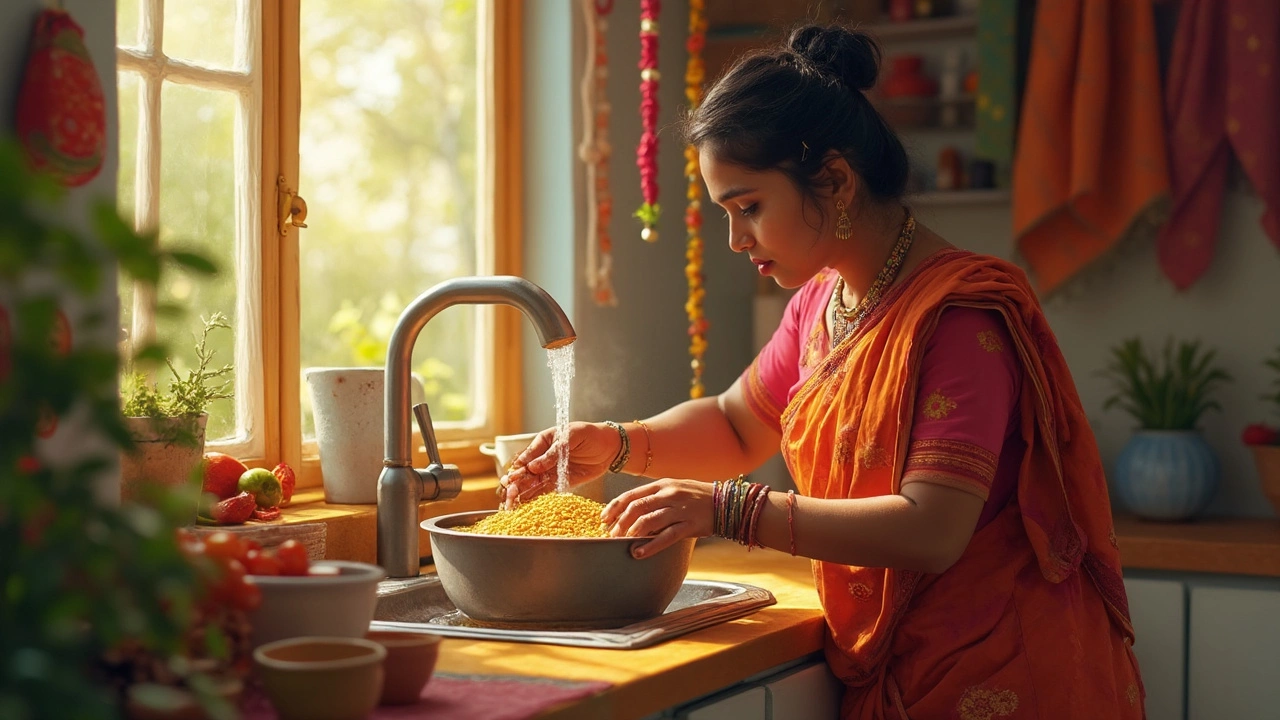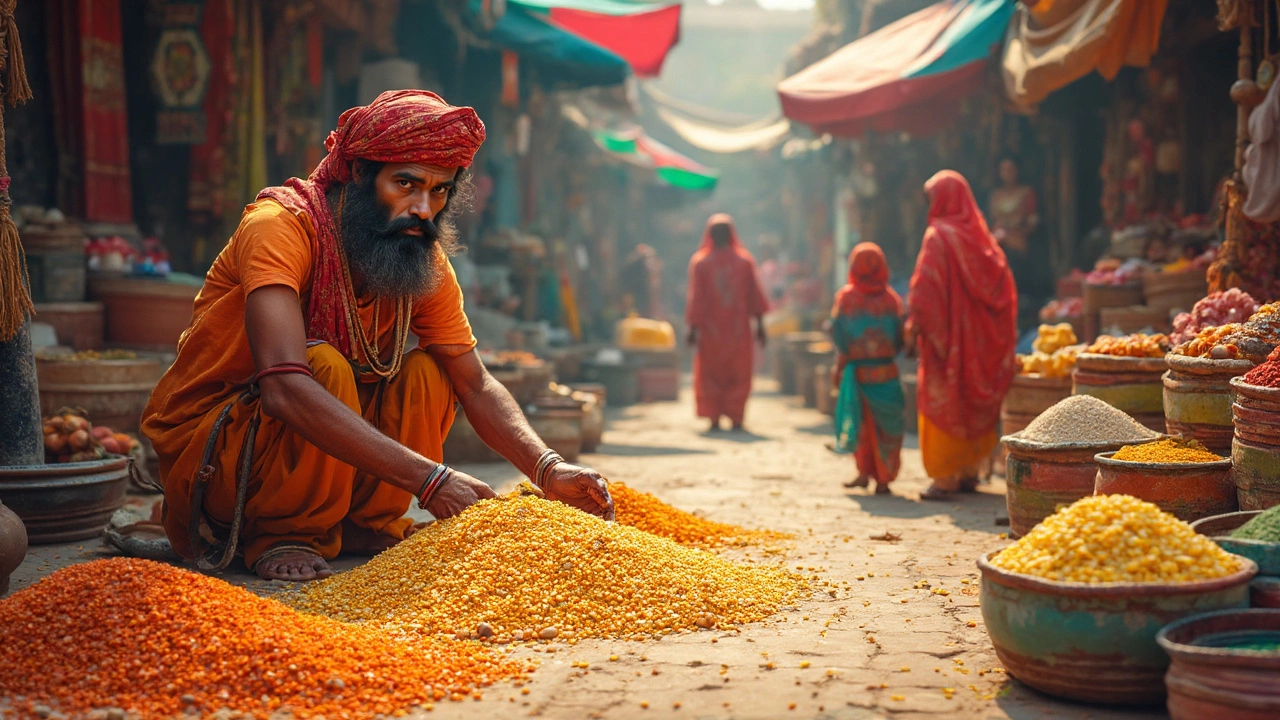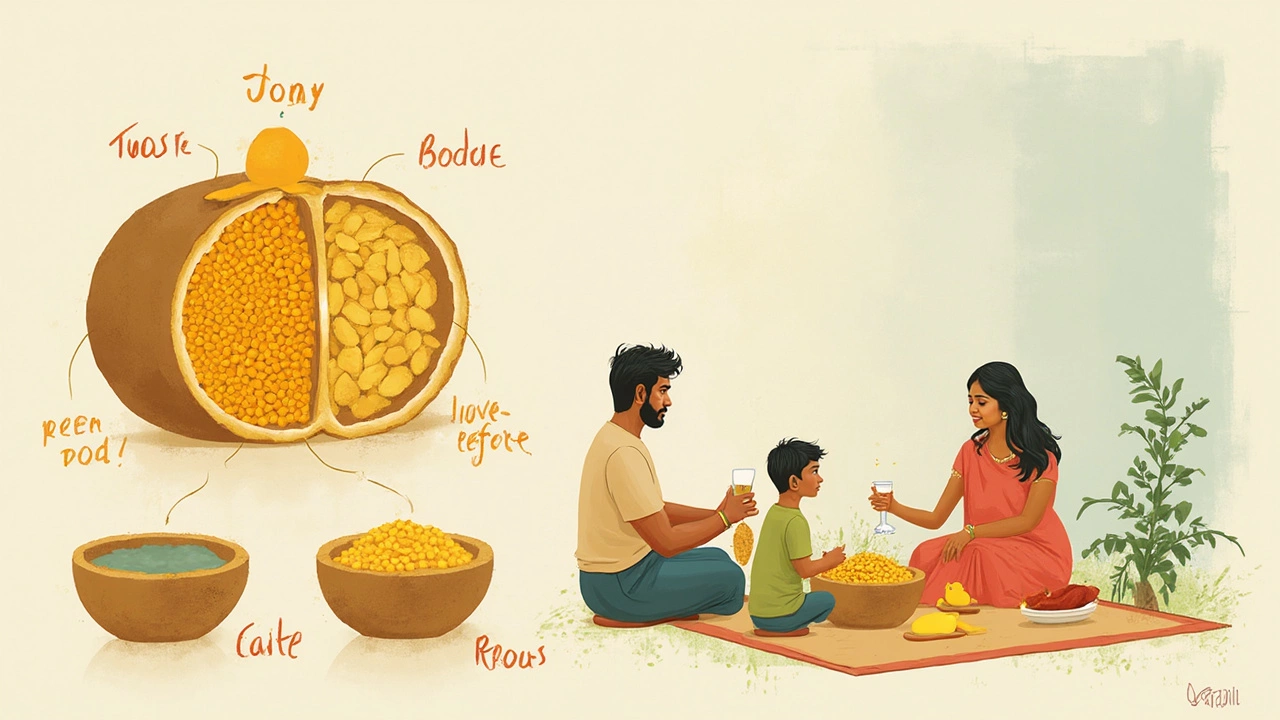Why You Should Wash Dal Before Cooking
 Feb, 19 2025
Feb, 19 2025
You might be wondering, what's the big fuss about washing dal before tossing it in the pot? Well, let's clear the air. Not washing your dal can leave behind dirt, dust, and sometimes even tiny stones that hitch a ride from the field to your kitchen. No one wants a gritty bite of dal, right?
Besides the dirt, there's also a bit of science behind that rinse. Dals, like lentils and beans, contain natural compounds that could cause belly trouble for some folks. Giving them a good rinse can help wash away some of these compounds, making your meal a tad lighter on the stomach.
- Why Skipping the Wash is Risky
- Hidden Dirt and Impurities
- Impact on Taste and Texture
- Digestive Health Benefits
- Quick Tips for Rinsing Dal
Why Skipping the Wash is Risky
Imagine scooping up a spoonful of your favorite dal recipe, only to crunch down on a tiny pebble. Not the most appealing, right? That's one of the risks of not washing your dal.
Dals come straight from the fields, and sometimes they bring a little bit of the field with them. This includes dirt, small stones, and even dust. Skipping the wash means all these impurities can find their way into your dish, affecting both the taste and safety of your meal.
Dirt and Dust Tag-Alongs
Dirt and dust naturally coat the surface of dals, especially when they're brought straight from agricultural areas. It's not just about the taste (though that does matter); dirty dal can change the acidity and texture of your dish in ways you don't want.
Risks to Dental Health
Those tiny stones or grains can do more than just ruin the taste—they can chip a tooth or hurt your gums. It's a surprising risk considering how soft and mild cooked dal is supposed to be!
The Nutritional Angle
Washing dal also helps remove some natural compounds called oligosaccharides. These can be tough on the digestive system for some people, leading to bloating and discomfort. So that rinse is actually doing more than just cleaning—it's making your dal easier to digest.
Overall, by skipping the wash, you might save a minute or two, but at the cost of taste, dental safety, and digestive comfort—none of which seem worth it with such an easy fix.
Hidden Dirt and Impurities
So, why is washing your dal such a big deal? Well, when lentils and other dals are harvested and processed, they often collect dirt and dust along the way. These can get into those tiny crevices on the surface of the dal. A few rinses under water helps shake off these unsavory bits.
Beyond dirt, there are also small stones or grit that may be hiding in your bag of dal. They sneak in during the sorting process and trust me, you wouldn't want to bite into one! Washing dal isn't just about cleanliness; it's also about avoiding a visit to the dentist.
Doesn't Washing Affect the Nutrients?
There's a common worry about whether rinsing dal washes away its nutrients. The good news? Most of the vital nutrients like protein and fiber remain intact, so you’re not missing out. If anything, you're enhancing the taste by removing impurities.
Here's a quick tip: use a wire mesh or colander and run cold water over your dal until the water becomes clear. This clarity indicates that the majority of dirt and dust has been washed away, leaving your dals ready for cooking.
| Common Impurities | Prevention |
|---|---|
| Dirt and Dust | Rinse until water runs clear |
| Small Stones | Carefully sort before washing |

Impact on Taste and Texture
You ever cooked dal and thought, 'Why does it taste a bit off?' Well, not washing it might be the reason. When you wash dal, you remove all the unwanted dust and grime that otherwise cloud the taste. A cleaner dal means a cleaner flavor profile, allowing the natural earthiness of lentils to come through.
Flavor Clarity
Especially with delicately flavored dals like moong or masoor, getting rid of impurities ensures that their subtle nutty and sweet flavors aren't muddied. It's kind of like tasting a glass of freshly filtered water versus a murky one.
Texture Matters Too
Washing dal also plays a role in its texture. Unrinsed dal can be gritty due to residual dust and even minor impurities. Give them a good wash, and they turn into plump, smooth bites that cook evenly. No more crunch where there shouldn't be!
Even if you're a fan of that creamy, melt-in-your-mouth dal, skipping the rinse means risking a jeopardized, uneven mush.
Extra Pro Tip
Here's a quick tip: after rinsing, soak the dal for about 30 minutes. This not only cleans but also hydrates the pulses for an even cook. Trust me, it makes a world of difference!
Digestive Health Benefits
We all know that a happy tummy makes for a happy day. For those who love their dal, washing it can really make a difference when it comes to digestion. Ever heard of phytic acid? It's this compound found naturally in grains and legumes, including our beloved dal, that might mess with digestion.
Washing your dal helps reduce phytic acid, which is known for binding essential minerals like iron, zinc, and calcium, making them harder for your body to absorb. So giving your dal a good rinse can help ensure these nutrients get through to where they’re needed in your body.
Less Gas, More Comfort
Ever experienced that uncomfortable bloated feeling after a delicious dal meal? Headlining this show are oligosaccharides, a type of carbohydrate present in lentils and beans that can cause gas and bloating. A simple rinse can wash away some of these troublemakers, leading to a more comfortable dining experience.
If you're prone to tummy troubles, it's a one-step fix that can make a world of difference. So, next time when you're preparing your favorite dal recipe, give those lentils a quick bath—your stomach will thank you later!

Quick Tips for Rinsing Dal
Alright, so getting your dal squeaky clean isn't rocket science, but doing it right can make your dish much more enjoyable. First thing's first: grab a fine mesh strainer. This little tool is going to be your best pal here.
Step-by-Step Rinsing Guide
- Start by measuring out the amount of dal you need. It's usually best to rinse just what you'll be using.
- Place the dal in your strainer, and hold it under cold running water. You'll want to swish it around a bit with your hands to shake things up and allow the water to wash away any surface grime.
- Continue rinsing until the water runs clear. This might take a couple of minutes depending on how dusty your dal is.
- Give the strainer a little shake to get rid of excess water before you transfer the dal to your cooking pot.
Remember, a good rinse can go a long way in improving the taste and texture of your dish. And hey, it might save you a trip to the dentist if you come across an unseen stone in your dal!
“Skipping the rinse can leave compounds that affect digestion,” says culinary expert Emma Lewis. “But a quick wash can make your meal much more enjoyable and lighter on the stomach.”
Additional Tips
- For certain types of dal, like moong or masoor, you can soak them for 10-15 minutes after rinsing. This softens the dal and cuts down on cooking time.
- If you're in a pinch for time, a quick rinse and thorough swish with your fingers should do the trick.
- For bigger batches, you might find it easier to rinse the dal in a larger container rather than a strainer, swirling it around before draining.
Stick to these easy steps and you'll be on your way to cooking up some delicious, clean dal in no time. Trust me, your taste buds and tummy will thank you!
